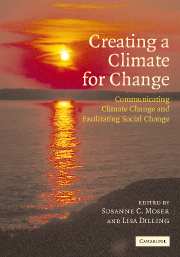Introduction
Published online by Cambridge University Press: 20 August 2009
Summary
It is June 23, 1988, a sweltering day in Washington, DC, and members of the US Senate Committee on Energy and Natural Resources are settling into their seats. What they are about to hear will change the direction of American politics forever. Up to the podium steps a six-foot middle-aged scientist, a little hoarse, a little nervous, and quietly vies for the attention of the eminent body.
The timing is perfect. Over 100 degrees outside and a deadly drought gripping much of the country, James E. Hansen, chief scientist of NASA's Goddard Institute for Space Studies, is here to nail the case for global warming. His message is simple and clear. “The greenhouse effect has been detected, and it is changing our climate now.” He states “with 99 percent confidence” that the evidence was in – the world was indeed getting warmer, and model projections pointed to worse heat waves and droughts in the future. As observers later recalled, “Besieged by the media afterward, [Hansen] said, ‘It's time to stop waffling so much and say that the greenhouse effect is here and affecting our climate now.’ Suddenly global warming – and Hansen – became world news.”
And world news it was. Not because of the news value of climate change – global warming had been buzzing around for a while – but because rarely if ever before did a scientist's warning set off such determined response. The June hearing was just the beginning. Seven hearings in the Senate and five in the House followed, each adding to the persuasiveness and urgency of the scientists' warning. […]
- Type
- Chapter
- Information
- Creating a Climate for ChangeCommunicating Climate Change and Facilitating Social Change, pp. 1 - 28Publisher: Cambridge University PressPrint publication year: 2007
References
- 15
- Cited by



